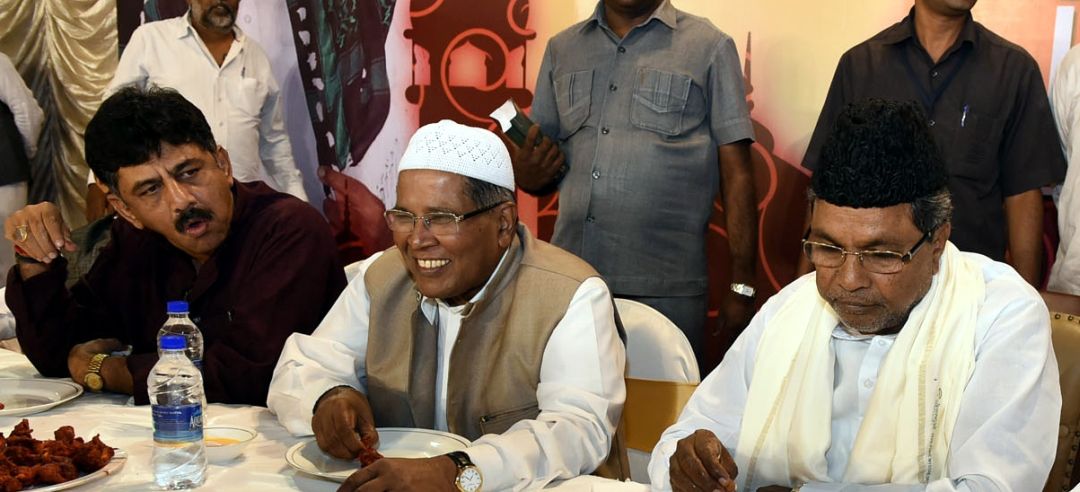The iftar, in its untampered form, is a simple event. After a long day without food or drink, the rozedar breaks his fast with friend and/or family. This simple and rather utilitarian event has merged with Indian politics to create the gala iftar party. Postures are struck and platitudes spoken to assure India's desperately poor Muslim community that the powers that be haven't forgotten them.
In this, clothing plays a key role in communicating the politician's message. The neta attends his Iftar galas in his jumma-best. Topis, keffiyeh, achkans and churidars, it's all brought out for the year's biggest fancy dress ball.
To get right to it, without a doubt, the winner of the competition this year are the Samajwadis
Ladies & Gentlemen, the #Arabs have arrived for the #Iftar Party in India. pic.twitter.com/CeQVUo5aCI
— Farhan Shaikh (@farhanknight) July 15, 2015The Trinamool's quizmaster-turned-politician Derek O'Brien puts in a more demure performance along with Delhi Chief Minister, Arvind Kejriwal. As Farhan Shiekh points out on Twitter though, the two Muslims next to them, Vice President Hamid Ansari and Delhi Lieutenant Governor Najeeb Jung didn't feel the need for a cap.
(It seems a startling coincidence that the Hindi idiom topi pehnana, to make someone wear a cap, means "to fool someone")
There are 2 Muslims in the pic. Both are without caps. And this explains what exactly is wrong with Indian politics! pic.twitter.com/AiYJk8dd1R
— Farhan Shaikh (@farhanknight) July 13, 2015O'Brien's boss, Chief Minister of Bengal, Mamata Banerjee iftars here in a white sari, with the pallu firmly covering her head.

Here Karnataka Chief Minister, Siddaramaiah, looking dapper in black faux astrhakhan cap, seems to be rather happy with his kabab.

Chirag Paswan, on the other hand, makes do with a rather more humble pakoda, while glancing covetously at his flunky's plate.

And here is last year's winner, Chandrababu Naidu in an Arab-style ghutra, which pretty much blew the competition out of the water.
Nara Chandrababu Naidu in a still from his forthcoming multilingual #ubersecular flick Arab Ne Bana Di Jodi. pic.twitter.com/dJv2x010iO
— Pathikrit Sen Gupta (@pathikrit2sen) July 22, 2014What about the BJP?
Muslim symbolism is much attacked by the Bharatiya Janata Party. As a party which attracts very few Muslim votes, it can mostly afford to take the moral high ground here. But even then, the temptation to put on a topi, eat some iftar and maybe get a picture clicked is sometimes just too much.
A picture for the day: Bharat Ratna Atal Behari Vajpayee. Do see. pic.twitter.com/hoB58qy12F
— Rajdeep Sardesai (@sardesairajdeep) July 15, 2015Our secularism might be a bit off kilter here in India but at least we're all in it together. Here Shazia Ilmi gets in a nice little photo-op at a temple.
@sardanarohit Sir, मत्था टेकने पहुंची @shaziailmi चढ़ाया दूध http://t.co/yofHc4oKdd http://t.co/qMkWZfdUq4 … … pic.twitter.com/pkqYmzTS7c
— KARTIK PATEL (@KKK78888) March 25, 2014And Modi?
Of course, one person who's been above it all, has been Narendra Modi. Back in the day, as Gujarat Chief Minister, he had forcefully stopped an imam from making him wear a skull cap, thus preventing an embarrassing photo-op (the imam is now, by the way, in jail for hate speech).
This is a fairly utilitarian calculation: unlike most other politicians, as head of India's far Right, Modi has more votes to lose than gain if he puts on a skull cap. Of course, that calculation says nothing about abjuring from a Sikh-style dastar.
The divisive face of Narendra Modi: If he can wear a Pagdi;then why did he object to wear a skull cap ? pic.twitter.com/okaNCqebjU
— VIKRAM GOKRAL (@vkey123) April 21, 2014As with so much else, believe it or not, Urdu short story writer Saadat Hasan Manto predicted this. His short story, Baaten, describes the terrible communal riots in Mumbai during the Quit India Movement. In it, he writes of the great advantages of having a flexible, utilitarian policy towards your mode of headgear:
During the Hindu-Muslim riots, whenever we would step out of the house for some work, we would keep two caps with us: one Hindu cap and the other, a Rumi cap. When passing through a Muslim neighbourhood we’d wear the Rumi cap and when we went to a Hindu neighbourhood then we’d put on the Hindu cap. In these riots (of 1942), we’d also bought a Gandhi cap. This we’d put in our pockets and whenever we’d sense a need, we’d put it on in a jiffy. Earlier faith would reside in our hearts, nowadays it resides in caps. Even politics, it seems, resides in caps. Zindabad caps!












